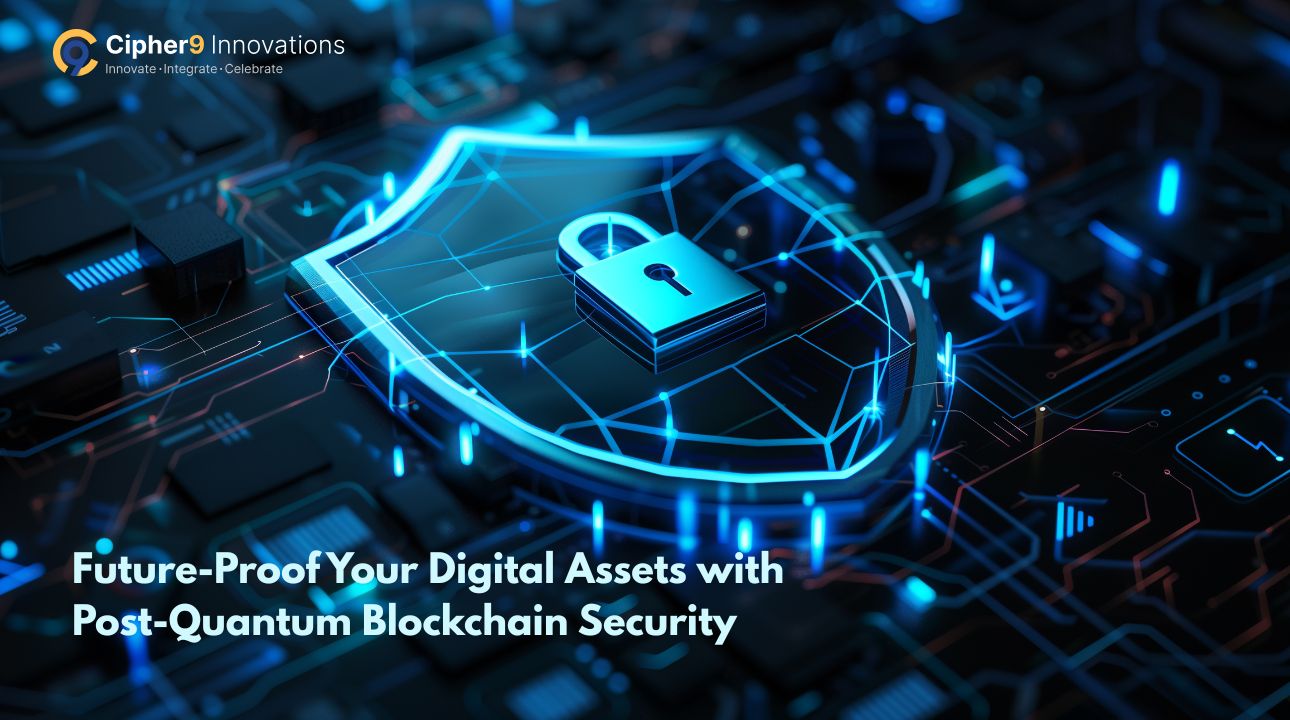
Introduction
Imagine a future where even today’s strongest cryptographic defenses are useless.
This isn’t science fiction—it’s the imminent reality of quantum computing. As quantum machines move closer to practical, real-world capabilities, they threaten to dismantle the cryptographic foundations that secure blockchain networks.
Blockchain’s core security mechanisms—digital signatures, public-private key encryption, and hashing algorithms—were designed to withstand attacks from classical computers. But quantum algorithms like Shor’s algorithm can break RSA and ECC encryption in seconds, undermining blockchain’s entire trust model.
The solution lies in Post-Quantum Blockchain Solutions—decentralized networks built with quantum-safe cryptography to ensure long-term data integrity, scalability, and security.
At Cipher9 Innovations, we help organizations transition to quantum-resistant blockchain architectures, protecting digital assets now and in the quantum future.
Post-Quantum Cryptographic Solutions
To counter these threats, blockchain networks must adopt Post-Quantum Cryptography (PQC)—algorithms secure against both classical and quantum attacks.
Leading quantum-resistant cryptographic methods include:
- Lattice-Based Cryptography
- Hash-Based Signatures
- Multivariate Polynomial Cryptography
Integrating these now ensures blockchain security before quantum attacks become mainstream.
How Quantum Computing Threatens Blockchain Security
Quantum computing offers unprecedented processing power—capable of solving mathematical problems that classical computers can’t touch.
While this breakthrough benefits many industries, it also breaks blockchain’s cryptographic backbone.
Today’s blockchain platforms rely on asymmetric encryption methods like RSA and Elliptic Curve Cryptography (ECC). These systems depend on problems that are computationally infeasible for classical computers—but trivial for quantum machines.
Quantum risks to blockchain include:
- Private Key Exposure – Quantum attacks could derive private keys from public ones, allowing wallet theft.
- Transaction Forgery – Hackers could create fraudulent transactions by forging digital signatures.
- Network Collapse – Once blockchain trust is broken, entire ecosystems could fail.
Post-Quantum Blockchain Solutions: How to Stay Secure
The best way to protect your blockchain from quantum threats is to use Post-Quantum Cryptography (PQC) — encryption methods that can resist both today’s and future quantum computers.
1. Switch to Quantum-Safe Cryptography
Move away from older methods like RSA and ECC, and use:
- Lattice-Based Cryptography – Strong security, even against quantum attacks.
- Hash-Based Signatures – Perfect for safe transactions and preventing fraud.
- Multivariate Polynomial Cryptography – Complex math that’s hard to break.
2. Build a Quantum-Ready Blockchain
Key steps for a secure future:
- Quantum-Safe Digital Signatures – Replace weak encryption with PQC methods.
- Upgradable Security – Use modular cryptography so you can update easily.
- Hybrid Protection – Run both classical and quantum-safe systems during transition.
- Secure Key Exchanges – Use PQC protocols like New Hope or Kyber.
- Faster, Safer Consensus – Improve speed without losing security.
- Long-Term Data Safety – Use quantum-proof hashing for decades of protection.
3. Solve Scalability Challenges
Quantum-safe methods can slow performance. To keep your blockchain efficient:
- Layer-2 Scaling – Use rollups, sidechains, or state channels.
- Data Compression – Reduce data size without losing accuracy.
- Optimized Consensus – Keep transactions fast and secure.
By acting now, businesses can future-proof their blockchain, protect assets, and stay ahead of cyber threats in the quantum era.
Scalability Challenges in the Quantum Era
Post-quantum algorithms often require larger keys and signatures, impacting:
- Block Size – Bigger signatures mean larger blockchain data.
- Transaction Speed – Increased computation can slow validation.
- Storage Needs – More data per transaction increases storage costs.
Scalability Solutions
To maintain performance, blockchain developers can implement:
- Layer-2 Scaling – Rollups, sidechains, and state channels.
- Data Compression – Reduce block size without losing integrity.
- Optimized Consensus – Balance speed and quantum security.
Evolving Key Management in a Post-Quantum World
Traditional wallets were not designed for quantum–safe keys, requiring major upgrades.
Future-Ready Key Management Trends
- Multi-Algorithm Support – Manage both classical and PQC keys during transition.
- Regular Key Rotation – Minimize exposure to attacks
- Hardware Security Modules (HSMs) – Store keys in tamper-proof, quantum-ready devices.
Best Practices for Quantum-Secure Key Storage
To ensure long-term blockchain security, businesses should:
- Adopt Hybrid Keys – Support both classical and PQC algorithms.
- Implement Frequent Key Rotation – Reduce attack windows.
- Leverage HSMs – Ensure secure, offline storage.
- Minimize Key Exposure – Avoid unnecessary reuse of public keys.
- Plan Migration Paths – Enable smooth upgrades without downtime.
Why Acting Now Is Critical
The quantum era is not decades away—it’s already in development.
Attackers are using the “Harvest Now, Decrypt Later” strategy: collecting encrypted data today to decrypt when quantum power becomes available.
By adopting Post-Quantum Blockchain Solutions now, businesses can avoid emergency overhauls, maintain compliance, and ensure the trustworthiness of their blockchain networks.
Cipher9 Innovations: Your Partner in Quantum-Safe Blockchain Development
- We specialize in:
Designing quantum-resistant blockchain platforms - Integrating post-quantum cryptographic algorithms
- Enhancing scalability & performance for the quantum era
- End-to-end blockchain security consulting
Whether you’re an enterprise, startup, or blockchain developer, we help you future-proof your network, protect digital assets, and stay compliant in a rapidly evolving threat landscape.
Conclusion
Quantum computing will redefine cybersecurity—and blockchain networks must evolve or risk obsolescence.
The shift to Post-Quantum Blockchain Solutions is not optional—it’s essential for preserving decentralization, trust, and data integrity.
The time to act is now.
Partner with Cipher9 Innovations to ensure your blockchain ecosystem remains secure, scalable, and quantum-ready.

